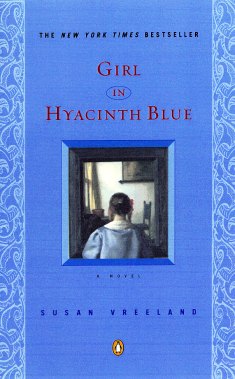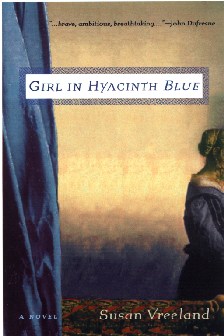














REVIEWS
GIRL IN HYACINTH BLUE
Among other things, Vreeland has given us an art detective story, since the early chapters suggest that this marvelous painting--a portrait of a young girl whose face seems to be filled with dreams and longings--may be a lost Vermeer. When we first encounter it, the picture is hidden from view, its possession the dark secret of a lonely mathematician whose father looted it from a Dutch Jewish family that he then sent to die in a concentration camp. Horrified by his father's crimes, he worships the painting with obsessional fervor, fearing that if anyone sees it, the secret of its provenance will come to light. But, as is the way with such things, he also feels compelled to show off his trophy.
The chapter that displays the mathematician's solitary, guilt-filled pleasure is followed by another that provides a lively view of the close-knit Jewish family from whom the painting was stolen--and particularly of the young daughter who identifies with its subject, a girl just about her own age. This sequence establishes the pattern for the book's structure: each chapter stands on its own, a marvel of economy, yet also builds on the knowledge the reader has already gained.
Vreeland is especially good at conveying the tensions that arise among her characters but go largely unspoken. She is also adept at capturing the differing sensibilities of various historical periods, working unobtrusively and successfully avoiding a contrived "period" feel. In the process, she provides her own nicely sketched gallery of portraits: a frivolous Frenchwoman marooned in a loveless marriage in the 19th-century Netherlands; an 18th-century farmer's wife hungering for beauty in the midst of the flat Dutch countryside; and an Enlightenment scientist who embarks on an affair with a superstitious serving girl.
In all these episodes, the painting is pivotal, both in a practical and a spiritual sense. The aristocratic Frenchwoman hates all things Dutch except the girl in the painting because she recognizes in her a sense of hope that she herself has lost. The farmer's wife loves the same girl because she symbolizes a serene loveliness that is unattainable for people who labor in the fields. In the end, each woman is forced to sell the painting so that each, in her own very different way, can survive. But for each of them, the possession of "Girl in Hyacinth Blue" leads to profound changes.
This conflict of the spiritual and the practical comes to dominate the final chapters of the novel in which the exigencies of the painter's life are movingly brought to the fore. Like many of its predecessors, the penultimate chapter is filled with a sense of tenderness, of gratitude for the gift of life--a mood that doesn't cloy because it is accompanied by a clear evocation of the daily stresses of loving and living. But the crowning chapter is the final one, which introduces the girl in the picture and provides a glimpse of what is actually going on behind those dreamy eyes.
Throughout "Girl in Hyacinth Blue," Vreeland strikes a pleasant balance between the timeless world of the painting as a work of art and the finite worlds of its possessors and admirers--not to mention the world of its subject and its creator. Intelligent, searching and unusual, the novel is filled with luminous moments; like the painting it describes so well, it has a way of lingering in the reader's mind.
--Katy Emck December 19, 1999
* GIRL IN HYACINTH BLUE
* GIRL IN HYACINTH BLUE
The only wobble in this elegant little book is at the start, where a stiffness in character may be intended but jars even so: a high-school math teacher confides to a colleague that he owns (and adores) a painting--of a girl sewing at a window--that he knows is a Vermeer. All the evidence--of technique, color, subject--is there, yet the painting lacks documentation to validate its authenticity: nor will the math teacher, one Cornelius Engelbrecht, tell just how it became his. The reader is more privileged, though, and learns quickly enough that Engelbrecht's Nazi father stole it in 1940 from a doomed Jewish family in Amsterdam. Such reader-privilege becomes an overwhelming emotional test when Vreeland goes back to visit that family, in that year, just before the theft ("A Night Different From All Other Nights"). Farther back still, a happily married Dutch couple owns the painting--and when the husband admits that the girl in it reminds him of an earlier lover, the marriage is briefly shaken ("Adagia"). Set when Beethoven's Eroica symphony is "new," "Hyacinth Blues" offers a biting bit of social satire--and lets the reader discover just how the painting's papers did in fact get lost. Still deeper back goes Vreeland, taking up with masterful insight, feeling, and control the life of a small Dutch farm family caught in the great flood of 1717; of a young engineer who loves, loses (pathetically), and hands on the painting; of Vermeer himself as he paints the picture, struggling against debt, father of 11; and, in a wondrous, bittersweet epiphany, of the daughter herself whom Vermeer chose as his model.
Extraordinarily skilled historical fiction: deft, perceptive, full of learning, deeply moving.
* GIRL IN HYACINTH BLUE
---Veronica Scrol
FOREWORD
GIRL IN HYACINTH BLUE
The fictional portrait, the "Girl in Hyacinth Blue," becomes the pearl that is not crushed as it is sold, stolen or tenderly given by one owner to the next. Though described as a novel, Vreeland's book is more a collection of short stories. Rather ordinary people own the work beginning in the seventeenth century when it was given by Vermeer's family to a baker to pay off bills. "Love Enough" relates that its present owner, an American professor, has hidden the painting because it reminds him of the terrible truth about his father's past.
The portrait has perhaps the most meaning for Vermeer's daughter, who appears in the final poignant story, "Magdalena Looking." In 1696, as a woman with bad teeth, she sees the painting at an auction and yearns to own it again. Magdalena recalls sitting for the portrait and remembers how she wondered then what she meant to her father. "Slowly, she came to understand that he looked at her with the same interest that he gave to the glass of milk." Yet, the reader knows from "Still Life" that for Vermeer, the glass of milk in the scene made "the whole corner sacred with the tenderness of just living," and at the moment of his inspiration, Magdalena stood before him "as if offered by God."
Vermeer enhanced his exquisite paintings with mundane objects; Vreeland places the girl's portrait in the possession of ordinary people leading ordinary lives.
Vreeland is an accomplished author whose first novel, What Love Sees, was broadcast in 1996 as a CBS Sunday night movie special. She teaches English literature, creative writing and art in the San Diego public schools.
Girl in Hyacinth Blue should appeal to readers who enjoy nontraditional love stories.
--Linda Salisbury
GIRL IN HYACINTH BLUE
In her magical second novel, Susan Vreeland guides us back through Dutch centuries to the moment of provenance of a painting that, in the present day, hangs in the study of a reclusive math professor. This still life of a young girl peering through a window serves as the emotional centerpiece in this finely woven series of tales, presented in reverse chronology. Each story in this novel is intimately related through an admiration for the innocence and beauty of the girl in the painting; and a varied expression of love by a melange of intriguing, real characters is a running theme.
"I have always had a fascination with old, old things," Vreeland says, tracing back the inspiration for "Girl in Hyacinth Blue." I have always been drawn to antiques, my first thought when I see medieval writings or ancient pottery being, 'One day, there was a man who fashioned that.' The life of the maker brief, the creation of his heart and hands remaining for centuries."
At the outside, readers are introduced to a professor struggling with a moral dilemma: This painting he loves--of a young girl seated at a table, gazing outward at an unseen landscape--was obtained during Nazi looting of a Jewish household during the Holocaust. The painting is unsigned, but it bears strong resemblance to the work of Dutch master Vermeer. His whole life the professor has been unable to share the painting, the girl, with the world, fearing that the atrocity behind her custody may serve to steal her from him. When he finally succumbs and invites a fellow professor--an art professor--over to his home, the ownership lineage is explored, first in real time by the visiting professor, and then back hundreds of years as Vreeland uses her narrative license.
In a touching fashion, we are introduced to the family of the Holocaust, the girl in the painting watching over them just days before they are removed from the house and taken to their deaths. Further back then, we see a precious married couple, struggling with their own nostalgic angst, offering the painting to their soon-to-be-married daughter. An aristocratic wife sells this girl in the hyacinth blue so she may escape a loveless marriage. We also see her sold to provide bread for a loving but struggling family, and we see her escape an 18th-century flood by an almost divine intervention.
It is not until the final section, when we are introduced to the artist and shown the very moment of inspiration and creation, that we meet her in person, a child full of youthful exuberance and longing for requited love. We hear her name for the first time, though we have known her for 300 years and watched her give so much love and provide hope to so many.
"I can recall when I was a child and sat with my great-grandfather, who was a painter," Vreeland says. "His gnarled knuckles around my little hand, we took a paint brush, combined colors, and I was amazed at how a lily appeared on the water-color paper. That moment of inspiration--it has been with me forever."
Vreeland's prose is deftly skilled and easy to read, though not trite. She enables the reader to explore the thoughts of characters omnisciently in some instances, and with a limited, first person view at other times, through varied narrators. Her depiction of Dutch history is engaging and thorough, but she never gets superfluous with drone description and minutiae.
Most remarkably, she has painted a masterpiece of her own with her words, created an image so vivid that readers may expect to see the "Girl in Hyacinth Blue" hanging on a museum wall.
Ultimately, though Vreeland spends considerable time describing the artwork, it is the stillness of the girl in the painting that provides an intimate portrait of the lives witnessed. We see through her eyes, as they look upon her owners--poor and rich, old and young--and cannot escape the power of love and sometimes cruel, unavoidable rigidity of the passage of time.
One of her characters says, "I came to see that knowing what love isn't might be just as valuable, though infinitely less satisfying, as knowing what it is." This is just one of many valuable lessons found within the content of this pocket-size book. The premise is fascinating, the presentation unique, and the artistry by which Vreeland intertwines the stories, introducing the tribulations and trials of the individuals and families long since passed away, is exceptionally engaging.
---Brian Fine